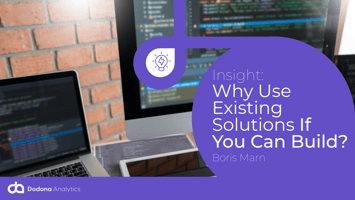Our CEO, Dr. Stefan Furlan, talks about the role of Charge Point Planning software in creating...

Whatever solution your business needs, you have a choice. You can either build it, or buy it. With Charge Point Planning (CPP) platforms, there are advantages and disadvantages to both approaches. CEO Dr. Stefan Furlan explains, giving his perspective.
Let’s set the scene - you’re a charge point business with a number of operational charging sites, and things seem to be ticking along nicely. You are noticing, however, the market’s pace is increasing in both speed and demand, and the competitor landscape is evolving faster than you’d anticipated.
You need to keep up, and after a bit of research, you find that the way to do it is to look at your charge point planning (CPP) process. There are solutions out there to help make your site assessment process a lot easier - bringing efficiency and accuracy to the procedure of choosing the next addition to your charging network. But why would you buy a platform, when you could build it in-house?
Why you might consider building your own CPP solution
We are in a developing market, with new tech and service companies popping up as demand increases and direction creates new painpoints needing to be resolved.
As a result, it might feel like there is nothing on the market which fits your requirements exactly. There may also be a desire to keep the company’s “secret sauce” in-house and protected from hungry competitors. And, at first glance, it could seem more cost-effective to direct resources into an in-house, owned solution which is tailored to the business’s needs.
Unfortunately, I will be using the can of worms analogy here, as there is more to developing a competitive CPP solution than first meets the eye.
Let’s examine the building blocks
There are four main building blocks you need to include when looking to build an in-house CPP solution which will stand the test of time, and within these a number of key aspects to consider:
- Product management
- Evolving data, model, and UI capabilities
- Organizational learning
- Optimization (hardware, development operations, data, models…)
- Contingency
- Business user-friendly interface
- Data and model visualization
- Interactivity / scenario planning
- Site assessment, identification, planning and delivery
- Site assessment models
- Data
- Sourcing data (open, proprietary & commercial data)
- Data ingestion, cleaning and consolidation
- Data upkeep, maintenance and optimization
- Developing your own data assets - what we call your “secret sauce”
Each aspect within these four main areas come with their own challenges, costs, and skillset requirements.
The question of cost
While both initial and ongoing costs for off-the-shelf CPP solutions are clear and agreed upon from the start, the same cannot be said when a company decides to build its own in-house.
While the obvious first step is to cost out the potential investment needed for the required product and its build, this initial estimate is rarely the end sum, with a high likelihood of costs never coming to an end due to unforeseen development and maintenance needs, along with the need to keep the solution competitive and in alignment with the market.
Hidden costs are usually generated most often from these areas of the solution build:
- Data - Commercial data, sourcing, as well as its upkeep, maintenance and optimization
- Product management - Evolving data, model, and UI capabilities, optimization, and contingency
These are also the areas where costs can be ongoing, even after the solution is in use and generating value.
Of course, the cost risk is different for every business - big tech can afford to hire more engineers, make mistakes, and invest resources to handle scaling the solution or solving problems in failed applications, but this can ruin a business whose core business is not software development, but finding profitable charging sites.
The skillsets required
Building an in-house CPP solution requires building an internal team with the right skills and support for the job. And, much like the ongoing nature of the costs of building, maintaining and developing an in-house CPP solution, its skilled build-team may also be needed to maintain and develop the product further as the market matures and business needs develop.
Let’s take a quick look at the kinds of skillsets necessary for a CPP solution build, and which building blocks they cover:
- Project manager - Product management evolving data models, and UI capabilities, and implementing organizational learning
- Data engineer(s) - Responsible for sourcing data (open, proprietary and commercial sets), ingestion, cleaning and consolidation, as well as upkeep and maintenance.
- Data scientist(s) - Responsible for the site assessment models, optimizing data, and developing in-house data sets
- UI developer - Ensuring a user-friendly interface, data and model visualization, interactivity/scenario planning, as well as site assessment, identification, planning and delivery
- Backend engineer & tester - Testing and optimizes the solution at many levels including hardware, development operations, data, models, and more
Each of these positions would need to be hired with a competitive employment package, and most will be required beyond the initial build. With comprehensive project planning, structure and delivery expertise also necessary, the skillsets considerations of building an in-house solution represent a significant additional cost, both initially and ongoing.
What cannot be bought- the secret sauce
An element of both a built solution but also a bought solution, should be your unique data assets and site assessment models - what we call the “secret sauce”.
These are assets which are uniquely relevant to your business and its goals, and something you want to protect. It is these assets and their configuration that give you a competitive edge.
Unfortunately, when building an in-house solution, around 95% of effort and resources is pumped into the build itself, into reinventing the wheel, while the business’s custom data sets and how they should be collated into the data model is given very little consideration.
Is it worth the wait?
And yes, there will be a wait. It will take time to develop a functional, tested, and optimized Charge Point Planning solution implemented and able to add value to the business, identifying feasible, viable and profitable charging sites.
Recruiting the expertise required, planning out the project from start to finish, then the actual delivery takes companies years. A Charge Point Planning solution - just like any software solution - requires maintenance, optimization and further development as the business and market it serves evolves.
Why buy a CPP solution instead?
As the founder and CEO of a company providing a complete Charge Point Planning platform, I am of course going to encourage charge point businesses to invest in a solution which is already on the market, but there is sound business reasoning behind this advice.
- It’s immediately available - Business can benefit immediately once a bought-solution is implemented, getting ahead of their competitors in expanding their network with new, prime charge point locations.
- No hidden costs - Pricing plans and contractual agreements are clear from the start, with costs for testing, maintenance, bugfixing, and development being the responsibility of the solution provider.
- Targeted to the needs of the market - A good CPP solution has the needs of the market and its customers in mind, and continually works to remain competitive as the industry evolves.
- Configurable for competitive advantage - The best CPP solution is out-of-the-box but also configurable to a business’s needs through an ability to ingest your unique data assets - aka its secret sauce - within its data models, delivering competitive insights via a site assessment which is aligned with a company’s specific criteria.
Summing up
In a fast-paced and evolving market, it is imperative that charge point businesses gain a competitive advantage now, building and expanding profitable charging networks and maintaining business momentum.
It is a fact that investing into a CPP solution plays a key role in achieving this success, and with proven solutions already on the market, choosing to build a CPP solution in-house is a bold decision. It might be the right decision for a certain type of company, but it is one which needs full consideration alongside the best-in-class CPP technology already out there.
You can learn about the Dodona Analytics CPP Platform here, or reach out to our team now.
.jpeg)
Stefan is the founder and CEO of Dodona Analytics and, following his PhD in Intelligent Systems, has been a serial data technology entrepreneur.
You can follow Dr. Stefan Furlan on LinkedIn



.jpeg?width=50&name=1516283627934%20(1).jpeg)

